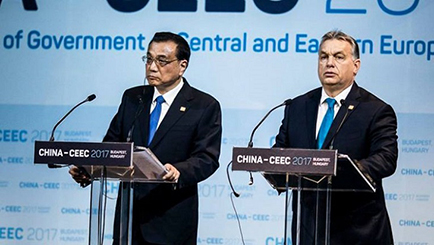
Will China BRI Cause East West Rupture in EU?
By F. William Engdahl
29 January 2018
On 27 November Hungarian Prime Minister Viktor Orban, already at odds with the unelected bureaucrats of the European Union over his insistence on the right to decide whether Brussels or national elected governments shall be allowed to become citizens in Europe’s ongoing refugee crisis, waved another red flag, this potentially a future game-changer for the EU as it exists today. Orbanhosted the 6th annual meeting of the China- Central and Eastern European Countries (CEEC) “16+1” summit in Budapest with China’s Prime Minister Li Keqiang. The event got barely a mention in western mainstream media despite the fact that it may have set the seeds for a divide within the EU within the coming months between a French-German-dominated federal EU run by Brussels and a more free, nation-based EU on the model of Hungary, Austria, Poland, the Czech republic and other east members of the EU . .
In his opening keynote speech, Hungary’s Viktor Orban noted that Europe’s most competitive investment environment has come into being in Central and Eastern Europe. Noting that not too long ago Asia depended on the west for investment in modernization, that today, “the star of the East is now in the ascendant”, and we live in an era marked by the rise of Asia – and within it China. “We are at the beginning of a period in which the further development of Europe will be dependent on the technological and financial involvement of the East.”
Orban stressed the summit was not against the EU. He stressed that the “16+1” format not only serves the best interests of China and the sixteen Central and Eastern European countries, but also the whole of Europe and the European Union. He then announced Hungary would begin public procurement tender for upgrading the Budapest–Belgrade railway line – including funding from China.The cost of the project is 2.4billion Euros, with 85% to be provided by Export-Import Bank of China. The project is the first European project involving an EU member, Hungary, a non-EU member Serbia and China. It will create a major modern freight route to Western Europe through Central Europe. Strangely enough this is not being greeted with joy in Brussels, rather the opposite.
The China-CEEC or 16+1 annual summit was launched in 2012 before formal inauguration of the Belt, Road Initiative by China in late 2013. Until this year it had little to present in terms of results. It served as a vehicle for China and the countries of Central and East Europe, the newest EU member states as well as applicant non-members to exchange information but little concrete. The BRI developments over the past year are beginning to radically change that.
In his speech to the summit Prime Minister Li Keqiang proposed more rail lines be launched by China Railway Express and more direct flights between China and Europe. He declared that China would like to set up a logistic center in the CEE region, likely in Hungary, a main China investment focus to date. He also announced the establishment of China-CEEC Inter-Bank Association and the second phase of China-CEEC Investment Cooperation Fund. The China Development Bank will provide funds equivalent to 2 billion euros ($2.4 billion) through development-oriented loans to the China-CEEC Inter-Bank Association, which was officially established at the summit, Li said. And he announced that the second phase of the China-Central and Eastern Europe Investment Cooperation Fund, totaling $1 billion, will be mainly spent in the 16 European countries. Li noted the strong growth of agriculture imports from the region to China, rising by 14% this year. Then he called for a feasibility study on extending to Austria a railway line linking the Greek port of Piraeus with Budapest.
Since 2012 China investment in the 16 countries rose by 300% from $3 billion to over 9 billion US dollars.
One-on-one economic diplomacy
The focus on the countries of Eastern and Central Europe by Beijing is a result of the ice-cold response to date of the EU in Brussels and especially by the German and French governments. For them China’s Belt, Road Initiative, sometimes called the New Silk Road, is a threat to their domination of the EU. The recent railroad by the decision of the German Agriculture Minister, to grant a new 5-year approval for the toxic glyphosate against the wishes of the majority of EU states is but an example of the heavy-handed Brussels methods, becoming more rigid as the resistance against heavy-handed Brussels refugee policies and countless other issues grows.
The 16 countries in the China-CEC group after the latest meeting all have formally signed on to participate in the China BRI on a one-be-one basis. The countries include Poland, Bosnia and Herzegovina, Croatia, Czech Republic, Estonia, Hungary, Latvia, Lithuania, Macedonia, Montenegro, Romania, Serbia, Slovakia and Slovenia, Albania and Bulgaria.
Greece, not formally a member of the 16+1 is already a major infrastructure focus of Chinese state investment in the EU. While Brussels and especially Germany offer Greece only more savage austerity demands since the Greek crisis in 2010, China offers investment. China has invested more than $500 million in the privatized Greek Port of Piraeus using the state shipping group, COSCO, turning it into the busiest Mediterranean port today. China has been operator of the Piraeus Port since 2008 and this April bought 67% ownership for $8 billion to the Greek government including the $500 million for modernization. The China Piraeus Port will serve as the gateway for Chinese seaborne freight into the EU, China’s largest trade partner. Now with the agreement by Hungary to complete the Belgrade-Budapest rail linkthe trade flows could become major for both China and EU countries of the CEE.
Greece took part in the founding meeting in May, 2017 of the Belt, Road Initiative and signed major economic agreements with Beijing.
EU Begins Counter-offensive
Rather that greet the Chinese investment in the ailing economies of Eastern and Central Europe, the Brussels EU Commission, dominated by Germany, is preparing to pass strict new investment rules. In September EU Commission President Jean-Claude Juncker, one who owes his job to Germany’s Angela Merkel, announced a proposal for a new EU rule to centrally control foreign investments into EU member states, another attempt to rob what little remains of member national sovereignty over their national economic development. The Juncker proposal, titled “Investment Screening”, if passed by member states, would require special scrutiny and approval from Brussels when a foreign state-owned enterprise wants to invest in EU ports, energy infrastructure or defense industries. Germany, France and Italy immediately praised the Juncker proposal. Here we see the fault lines that will only become more obvious as EU economic strains grow in coming months.
Austria could play a determining role in such a shift. In October the conservative Austrian People’s Party (ÖVP) won a victory making Sebastian Kurz prospective Chancellor in a coalition with the euro-skeptic anti-refugee Freedom Party (FPÖ). Hungary’s Orban has welcomed Kurzas a “close ally.” For the Austrian economy, to orient towards the neighboring countries of Eastern Europe, especially Hungary now that the two are closer on resisting forced refugee policies and other heavy-handed moves of Brussels, could initiate a major tectonic shift in the political weight inside the EU.
For Austria the cooperation with China’s Belt, Road Initiative makes huge sense. For Austria, engagement with China and the BRI is clear given the country’s strong economic relations with Eastern Europe and the Western Balkans. The countries of CEEC have major infrastructure deficits and Austrian industry could play a constructive partner role to the Chinese investment, what the Chinese like to call win-win. Clearly the present direction of the German-French-domination of the EU cannot continue as it has. The fault lines are too great.
The Danish Saxo Bank head of macro-analysis, Christopher Dembikin a recent assessment of these growing fault lines predicts “The divide between old core EU members and the more sceptical and newer members of the bloc will widen to an impassable chasm in 2018 and will shift the center of gravity from the Franco-German axis to Visegrad-and-friends (Hungary, Czech Republic, Poland and Slovakia-w.e.).”
Dembik suggests that the French Macron “EU reform” plans to integrate further and create a joint treasury and a common defense budget, more top-down rule, will push the countries of the CEEC, and likely Austria and also Italy to create a new blocking minority coalition of 13 EU countries to form a blocking minority at the European Council within the EU states that will push the EU to abandon the disruptive German refugee policies and austerity in favor of economic stimulus. That indeed would be a refreshing change for millions of Europeans. An outrageous prediction? Perhaps not so unlikely at present.
F. William Engdahl is strategic risk consultant and lecturer, he holds a degree in politics from Princeton University and is a best-selling author on oil and geopolitics, exclusively for the online magazine “New Eastern Outlook”
